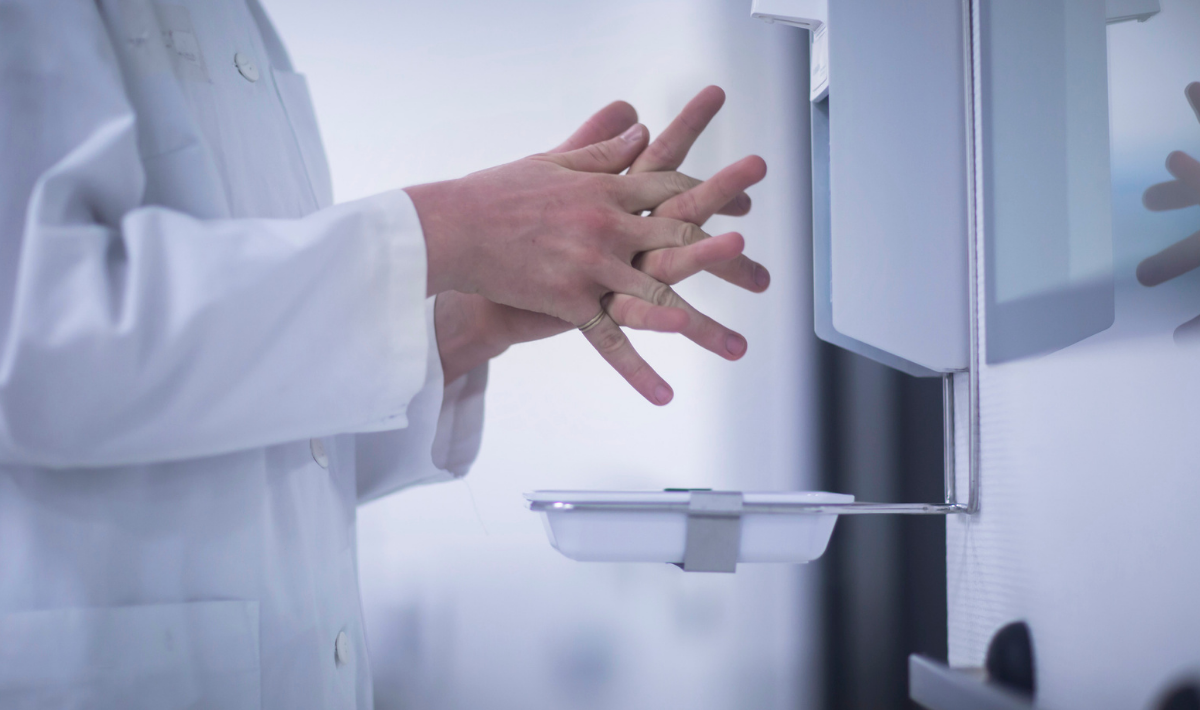By Laura Thill
When it comes to infection control protocols, get it in writing
Ensuring that infection control protocols are followed consistently throughout a group dental practice can be a huge undertaking. But, by placing the right people in charge and providing written protocols for each facility to follow, it can be accomplished, say experts. In fact, anything less than this could place the practice – including the staff and patients – and the group at large at risk for life-threatening health issues and insurmountable financial liability.
Indeed, as large dental groups continue to emerge, having a comprehensive, written set of infection control protocols in place has become increasingly more important. “Dental groups tend to grow quickly and don’t always have infection control protocols,” says Heidi Arndt, RDH, BSDH, president of Enhanced Hygiene, a group dedicated to the support and development of dental hygiene teams. Or, if they do have protocols in place, they don’t always assign and train staff to ensure that they are carried out, she notes.
Formerly, Arndt worked with American Dental Partners, which includes 23 dental groups and 250 dental practices. “At American Dental Partners, we believed that each practice should follow the Accreditation Association for Ambulatory Health Care (AAAHC) standards,” she says. (AAAHC accreditation means that an organization participates in on-going self-evaluation, peer review and education to continuously improve its healthcare, including adhering to infection control guidelines.) This was “a driving force” in ensuring that each practice adhered to the group’s infection control protocols, she points out. “At each practice, an operations person, as well as a dental hygienist or dental assistant, would be assigned to oversee quality assurance and infection control,” she explains. “[He or she] would run through a checklist and report to a quality assurance director. The quality assurance director, [in turn], would address any concerns with the go-to person at the practice.”
Hugh Norsted, DDS, an accreditation surveyor for AAAHC for over 25 years, agrees that having a written set of infection control protocols in place is essential to ensuring that each practice within a large dental group adheres to the group’s policies. “Over time, there are changes in staff and leadership at each practice,” says Norsted, who was a co-owner of Minneapolis-based Valley Dental Group before retiring in 2008. “In order to effectively train staff in infection control guidelines, you need written, easy-to-understand standards and policies – particularly when it comes to sterilization.
“The Centers for Disease Control and Prevention (CDC) has issued guidelines for infection control practices in dental offices,” he continues. “In fact, its last edition was in 2003, and an update is anticipated soon. Many state boards look to these guidelines as a standard, and AAAHC relies on them as a reference.” OSHA standards and guidelines also are designed to protect dental and medical staffs from infection, but patients benefit as well, he adds.
More than one person in charge
Maintaining a good infection control program calls for a team effort – and a well-trained team at that, note experts. “It’s key for dental offices to designate a couple of people who can attend infection control programs and take continuing education classes, and then bring that back to the practice,” says Norsted. “Many states mandate continuing education for dental staff in infection control. For example, New York has created its own program and Minnesota has core requirements for infection control course attendance that dentists must meet to retain their license.” The problem, he adds, is that while dentists or hygienists might attend continuing education classes, they don’t always share that information with the rest of the staff. “And, state boards typically do not inspect dental practices every three years,” he says. “When they do, it is usually in regards to a complaint, or they focus primarily on sedation policies. So, often, dentists are left to their honor to understand and implement current infection prevention and control standards.”
As group practices expand, they require cross-training programs to ensure consistency throughout the organization, notes Arndt. “We had cross training at ADP,” she says. “We would educate new clinicians, including front office staff, on our standards and expectations.” It’s much more difficult to backtrack and repair a situation than to do it correctly from the start, she adds. “Years ago, I worked in hygiene for a group and oversaw 23 practices. [Protocols] can vary from one office to another, which is why cross-training is so important.”
ADP schedules routine senior meetings to cover a gamut of points, from infection control to office productivity, quality assurance and more, she points out. “We wanted to know exactly what was going on at each practice.
“The biggest mistake is placing one person in charge,” she continues. “You need a management team at each practice that is aware of the infection control standards and expectations.”
Indeed, a dental group might have good policies in place, says Norsted, “but they need a certain level of observation and documentation. Surveillance is critical to ensuring compliance. [Dental offices] need to keep checklists, log books and have a good surveillance system, and they should retain their records for about three years for state inspections.”
Key points
A good infection control program should cover a range of points, including the following:
- Hand hygiene and the use of gloves.
- Safe injection practices. Dentists should always use new, sterile needles and NEVER mix carpules.
- Barrier protection.
- Hard surface disinfection.
- Instrument sterilization.
- Management of sharps and needle/sharps disposal. (Are used needles and blades being properly transferred to tamper-resistant containers, and are the containers removed when they are filled?)
“It’s hard to believe but some practices don’t use new needles for each patient,” says Norsted.
Arndt, too, has seen some hair-raising actions on the part of dental staff, although these were connected with solo practices – not ADP, she points out. “I have seen hygienists walk out of an operatory still wearing their gloves, and then touch things in the hallway,” she says. “I saw one hygienist walk down the hall carrying an instrument after working on an HIV-positive patient! I have seen staff remove sterilized instruments with their bare hands!”
During the exam, dentists and staff should wear masks, safety glasses, lab jackets and gloves, she explains. At the end of the exam, they should remove their masks and gloves, and appropriately dispose of needles and/or process instruments for sterilization. “These are safety precautions for both the patients and the staff.” The potential transmission of hepatitis, influenza and airborne germs via instrument- and drill-spray are all real concerns, she adds, noting that sometimes solo and newly emerging practices “don’t have the necessary awareness around infection control.”
Liability huge
Accidents happen. Patients have been known to swallow crowns and it’s not unheard of for a dentist or hygienist to be stuck with a needle. But, when an incident does occur, the liability can be monumental. “Once an incident gets into the press, it becomes a huge PR issue,” with legal and malpractice implications, says Norsted. “If a dental office is treating a large number of patients, and it needs to send a letter out [asking] all of those patients to come in for hepatitis testing, it can mean a huge financial, PR and legal liability.”
Again, it comes down to ensuring the right protocols are in place for the practice to follow. “The entire team must be aware of the infection control protocols,” says Arndt. “This concerns non-clinical staff as well. They are often the eyes and ears of a practice. They see a lot of what goes on and need to know the proper protocols, standards and expectations. And when you are dealing with a large volume of people, it takes more than one person to oversee this.”
“Communication, education and documentation are key to ensuring infection control,” says Norsted. For a large group practice, one way to handle miscommunication and oversight is to “break the process down into components” so that a national team oversees regional teams, which in turn manage smaller groups and practices, he points out. Clinical and non-clinical staff at each practice must be responsible and accountable as well, he adds. “Lack of communications and [an inability] to oversee that infection control protocols are being followed is the greatest challenge.”
A Culture of Safety
Get it in writing, says dental educator and consultant Nancy Andrews, RDH. When educating dentists and staff on infection control protocols, “everything must be in writing and people constantly need to be re-educated and re-assessed,” she points out. This affects what types of products an office purchases, she adds. In the case of masks, the office must ensure they fit properly and accommodate potential staff allergies. “And, different masks are appropriate for different procedures,” she adds. “An office needs enough masks, and everyone needs to know how to use them and what their limits are.”
“Everyone needs to be on board when making decisions as to which masks or gloves to purchase,” she continues. But this depends on “a culture of people wanting to comply with infection control protocols and standards.” And, that’s not always the case. “There are dental practices where the staff doesn’t feel it has the power to change poor practices,” she says. “The staff needs to be aware of why infection control is so important, and empowered to follow the correct protocols and speak out when those protocols are not being followed.” If a practice has a program in place to prevent errors from occurring, as well as the ability to identify errors when they do occur, they are ahead of the game, she adds.
The office needs to gain the trust of its patients as well, says Andrews. “If patients believe a dental office is clean and that the staff is trying hard [to follow infection control standards] but get a call that the sterilization equipment failed, they are less likely to sue the office,” she says. “Patients notice when the staff doesn’t wash their hands or wear gloves and masks. The staff needs to establish a culture of trust with the patients.
Yes, errors can occur, which is why group practices need liability insurance, she says. At the same time, however, “the staff at each office needs to show patients that it’s taking steps to ensure infection control.”





